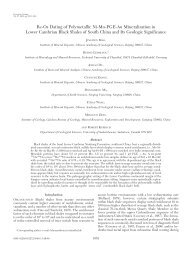Uranium Ore Deposits
Uranium Ore Deposits
Uranium Ore Deposits
Create successful ePaper yourself
Turn your PDF publications into a flip-book with our unique Google optimized e-Paper software.
EDUCATION<br />
Natural nuclear reactors<br />
It is interesting to know that nuclear reactors are not<br />
only man made, but also occurred in nature in a specific<br />
time window when two conditions were met: (1) Enough<br />
oxygen was in the atmosphere to allow mobilization and<br />
transport of uranium by warm water, and local precipitation<br />
of uraninite, as today in high-grade unconformity- and<br />
sandstone-type U deposits; (2) The proportion of 235 U in<br />
natural uranium was about ≥ 3.5 % which was realized at<br />
about 2 Ga and beyond, given the about six times shorter<br />
half-life of 235 U compared to 238 U. These two conditions<br />
bracket the natural formation of a critical mass of uranium<br />
at the time of about 2.0 - 2.4 Ga. Natural nuclear reactors<br />
were discovered in the 2 Ga Franceville basin in eastern<br />
Gabon in 1972 where 16 natural nuclear reactors are known<br />
so far. These reactors operated based on ore concentrations<br />
in sandstone of ≥ 20 % U with then 3.7 % 235 U, and water<br />
acted as moderator to slow down high-energy neutrons<br />
to be able to be absorbed by 235 U atoms and trigger fission.<br />
As the chain reaction proceeds, however, it generates heat<br />
which boils away the water, dries up the reactor and shuts<br />
it off. Similar to a geyser in a geothermal field, the process<br />
then starts up again after recharge by cold groundwater.<br />
Fissiogenic Xe and Kr trapped in alumino-phosphate<br />
minerals allows a detailed reconstruction of the life cycles<br />
of these reactors which operated over 150,000 years,<br />
with probably 30-min active pulses separated by 2.5-h<br />
dormant periods for water recharge (Meshik et al. 2004).<br />
The energy released during the life time of these reactors<br />
is estimated at ~15 GWyr, and about 50 % of this energy<br />
came from „breeding“, i.e. internal production of 239 Pu from<br />
neutron capture of 238 U, and α-decay of 239 Pu to 235 U. Even<br />
more astonishing, these open-system breeder reactors did<br />
not contaminate large areas, but their toxic and radiogenic<br />
components behaved essentially immobile over their 2 Ga<br />
history until today, due to the reducing and argillic nature<br />
of the country rocks. This natural analogon of a nuclear<br />
waste repository is relevant for the current discussion on<br />
safety of waste storage.<br />
Fig. 13:<br />
<strong>Uranium</strong> distribution in the<br />
Earth‘s crust. The bars<br />
represent various categories<br />
of uranium deposits<br />
(in blue) or geological<br />
repositories of uranium<br />
(in red). The currently<br />
mined uranium deposits<br />
have a very large grade<br />
range from a few hundred<br />
g/t to about 20 %. The<br />
arrows locate the grade<br />
at the extremes of this<br />
range, with the giant and<br />
low-grade Olympic Dam<br />
Cu-U-Au mine in Australia,<br />
and the very-highgrade<br />
unconformity-type<br />
U deposit of Cigar Lake in<br />
Canada (in development).<br />
Adapted from Deffeyes and<br />
MacGregor (1980).<br />
Issue 02 | 2008<br />
www.advanced-mining.com<br />
25










